#Brâncoveanu
Video
Palatului Brâncovenesc de la Mogoșoaia by Radu din Dacia
Via Flickr:
2023
#Palatului#Brâncovenesc#de#la#Mogoșoaia#Constantin#Constandin#Brâncoveanu#ungrovlahia#violet#verde#septembrie#2023#enpleinair#In aer liber#pictura#paint#panza#canvas#Art#impressionism#post-impressionism#realism#Pointilism#Pointillism#flickr
2 notes
·
View notes
Text
CULTURA ROMÂNEASCĂ ÎN TIMPUL LUI CONSTANTIN BRÂNCOVEANU
Articolul prezintă câteva informații despre cultura românească în epoca marelui voievod și martir Constantin Brâncoveanu. După o scurtă introducere și o prezentare biografică, lucrarea va detalia principalele direcții ale culturii brâncovenești: cărțile, bisericile și monumentele, prezentându-se apoi, ca un corolar, sfârșitul martiric al Brâncovenilor.
Europa din secolul al VIII-lea este o lume…

View On WordPress
0 notes
Text

Bishop Sebastian of Slatina and Romanați wore an epigonation with the faces of the Holy Brâncoveanu Martyrs on the feast of the saints, August 16, 2023. Photo credit: Metropolis of Cluj / Ionuț Chifa
5 notes
·
View notes
Text
Retrospectivă istorică privind începuturile activităţii de informaţii pe teritoriul românesc
Jurnalul: Intelligence Info, Volumul 1, Numărul 1, Septembrie 2022
Pagini: 29-38
Autori: Tiberiu Tănase
Limba: română
DOI:
Cuvinte cheie: activitatea de informaţii, Ţările Române, Şerban Constantin, Constantin Cantemir, Constantin Brâncoveanu, servicii secrete
URL:…

View On WordPress
#activitatea de informaţii#Constantin Brâncoveanu#Constantin Cantemir#Şerban Constantin#servicii secrete#Ţările Române
0 notes
Text
Laureatii Galei Premiilor Constantin Brâncoveanu
Cea de-a IX-a ediție a Galei Premiilor Constantin Brâncoveanu și-a desemnat laureații
Peste 600 de oameni au participat aseară la Gala Premiilor Constantin Brâncoveanu, unul dintre cele mai mari evenimente culturale din țară, ce a avut loc la Ateneul Român. Gala este organizată anual de către Fundația Alexandrion încă din 2014 și premiază personalități excepționale care, de-a lungul carierei,…

View On WordPress
0 notes
Text



























Kodak Edupe 200 exp. 2004 during in A blink of an ear workshop and exhibition set-up
&also some shots by Raluca, Brâncoveanu (p. 27, 24, 23)
#35mm#sound art#exhibition#evenimente#preparing#set-up#exhibition set-up#conteporary art#workshop#cav#centrul artelor multimedia#bucuresti#bucharest#romania#in a blink of an ear
4 notes
·
View notes
Text
Architecture
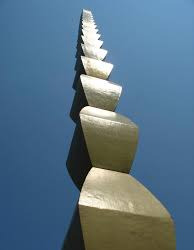

Coloana Infinitului (The Endless Column)- Constantin Brancusi
Brancusi was a Romanian sculptor, painter and a photographer who made his career in France,In 1918 he sculptured a remarkable statue. The sculpture is 98-foot-tall (30 meter) column of zinc, brass-clad, cast-iron modules threaded onto a steel spine. .This Endless Column is the earliest extant version of a motif to which Brâncuși would return over the course of his career. In previous years Brâncuși had used a doubled pyramid as a base for his sculptures, but he realized that this abstract block could be multiplied into a pillar form, a fully realized work in its own right. It is carved from oak. This was his first ways and ideas he had in mind before the original was made.To this day, their are pieces of his work in New York museums and different sculptures he had designed.
Fortified churches
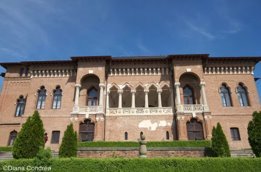

Constantin Brâncoveanu was the Prince of Wallachia between 1688 and 1714.He also created a beautiful ‘Brancoveanu’ architectural style. You can admire it in many old churches from Bucharest and also at Mogosoaia Palace. This is shown in the first picture.
The fortified churches from Transylvania are some of the most authentic and inspiring travel attractions in Romania. A fundamental part of the Saxon heritage that transforms the region into a great destination.
Biertan was centuries ago a prosperous village competing with nearby Mosna and Medias for regional control. The construction of an imposing fortified church was yet another element used to increase its chances in this political race.You may see this church in the second picture.The Biertan church one of the few that preserves its original altar, pews, and stone carved pulpit, all from the 16th century. Not to mention its unique locking system of the vestry door and the marital prison organised in one of its towers.
Luminita Machedon and Scoffham, E.R. (1999). Romanian modernism : the architecture of Bucharest, 1920-1940. Cambridge, Mass.: Mit Press.
2 notes
·
View notes
Photo

- The Mogoșoaia Palace of Ilfov in Romania. -
~ “Mogoșoaia Palace, historical building in the town of Mogoșoaia, Ilfov county, Muntenia, Romania, located about 15 km from the centre of Bucharest. The complex contains the building itself, its courtyard with the watch tower, the cuhnia (kitchen), the guest house, the ice house and the vault of the Bibescu family, as well as the ‘Saint Gheorghe’ church located near the walls of the courtyard.
The Mogoșoaia Palace was in the possession of the Brâncoveanu family for approximately 119 years, then passing into the ownership of the Bibescu family.
The palace was built until 1702 by Constantin Brâncoveanu in the Brâncoven style, a style previously used in another voivode's palace, built by him in Potlogi. The work was finished on September 20, 1702, according to the inscription on the east side of the palace. The date of the start of construction is not known, but it is known that Brâncoveanu started buying land in the area in 1681.
The Brâncovens after the death of the ruler (1714-1832).
After 1714, when Constantin Brâncoveanu was executed in Constantinople together with his sons, all the family's wealth was confiscated by the Ottomans and the palace was turned into an inn. Redeemed by the ruler Ștefan Cantacuzino, it then returned to the great ban Constantin Brâncoveanu, the ruler's grandson, and remained in the family's possession until the beginning of the 19th century.
The palace was devastated by the Ottomans during the Russian-Turkish war of 1768-1774, because the great ban Nicolae Brâncoveanu had sided with the Russians in the conflict. Another destruction of the palace took place on the occasion of the revolution of 1821 when the last descendant of the Brâncoven family, Grigore Brâncoveanu, fled to Brașov and the building was occupied by the Pandi.
Residence of the Bibescu family.
After Grigore's death in 1832, the Mogoșoaia property was inherited by his adopted daughter, Zoe Mavrocordat, and through her marriage to the ruler Gheorghe Bibescu, concluded in 1826, it passed into his family. The palace was renovated between 1860–1880 by Nicolae Bibescu, who also built the family vault in the palace park, and the nearby Elchingen villa. The palace was still administered by the Bibescu family who, however, moved to the new villa and the old building remained uninhabited. This until 1911, when Maria-Nicole Darvari sold the palace to her cousin George-Valentin Bibescu, who gave it as a wedding present to his wife, Martha.
The era of Martha Bibescu (1912-45).
Martha Bibescu took care of renovating the palace starting in 1912. During the First World War, the renovation works were hampered by further destruction suffered as a result of the German bombings. During the German occupation of Bucharest and southern Romania, Princess Martha Bibescu remained in the capital, taking care of Queen Maria's hospital and living in the palace for a while.
Returning to the country after she had gone to London, being accused of collaborating with the German troops, Martha Bibescu resumed the renovation works after 1920, spending a large part of the wealth collected from the books she wrote. Thus, the palace was re-inaugurated in 1927, with some interior works continuing, however, until 1935. While it was owned by Marthea Bibescu, the palace was visited by personalities such as August von Mackensen, Charles de Gaulle, Marcel Proust, Nicolae Iorga, King Alfonso XIII of Spain, King Carol I of Romania, Queen Maria of Romania, King Ferdinand I of Romania or Winston Churchill.
During the Second World War, the palace was a meeting place for allied diplomats, being, for a few months, rented to the Swiss legation in Romania.
Under the communist regime (1945-89).
After March 6, 1945, the estate was forcibly nationalised by the communist government, Martha Bibescu obtaining from the authorities the declaration of the palace as a historical monument, which she still owned. However, the princess left the country for good in September 1945, leaving the palace to her daughter Valentina and her husband, Dimitrie Ghika-Comănești, son of Eugen Ghica-Comănești.
In 1949, the palace was also nationalised, Valentina and Dimitrie Ghika-Comănești were arrested. By 1957, the building was ravaged and ransacked, the art collections stolen and dismantled. It was only in 1957 that the palace became the seat of the feudal section of the National Art Museum, being restored starting in 1977.
After 1990.
Currently, the Mogoșoaia Palace houses the Brâncoveneasc Art Museum and is an important tourist attraction.
Starting from 2010, the legal heirs of Marthea Bibescu, who live in Great Britain, are fighting in court for the recovery of the complex, or if necessary for obtaining adequate compensation.” ~
5 notes
·
View notes
Text

16 august: Sfinții Martiri Brâncoveni: Constantin Voievod cu cei patru fii ai săi, Constantin, Ștefan, Radu și Matei și sfetnicul Ianache
Sfântul Constantin Brâncoveanu, fiul voievodului Matei Basarab, s-a născut în anul 1654. Când părinții săi au murit, a fost crescut de unchiul sau, Constantin Cantacuzino. După un an, un alt unchi, voievodul Șerban Cantacuzino, a decedat pe 19 octombrie 1688, iar Constantin Brancoveana a fost ales să-l succeadă ca domn al Țării Românești
https://www.diane.ro/2024/08/16-august-sfintii-martiri-brancoveni.html
0 notes
Text
Welterbe (auf)gespürt und (er)fahren - RO - Kloster Horezu
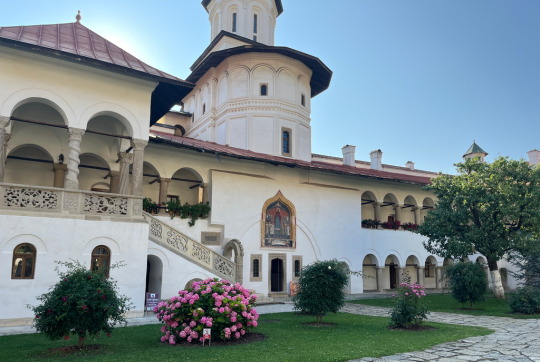
Rumänien verabschiedet sich von mir genauso fulminant, wie meine Tour durch dieses Land begonnen hat. Ich besuche das Kloster Horezu.
Das Kloster Horezu wurde 1690 von Prinz Konstantin Brâncoveanu gegründet. Es ist berühmt für seine architektonische Reinheit und Ausgewogenheit und den Reichtum seiner skulpturalen Details. Seine volkstümliche religiöse Malerei (Votivporträts) und seine gemalten Dekorationen machen es zu einem Meisterwerk des Brancovan-Stils. Die im 18. Jahrhundert im Kloster gegründete Schule für Wand- und Ikonenmalerei war in der gesamten Balkanregion berühmt. Das Kloster Horezu steht seit 1993 auf der UNESCO-Welterbeliste und hier gibt es ein Einführungsvideo.
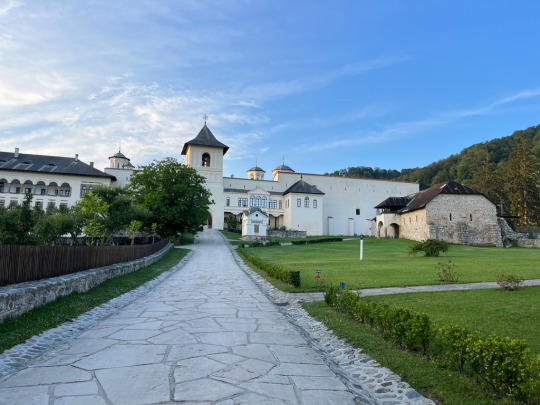
Weithin sichtbar steht das weiße Kloster oben auf dem Berg über dem Ort.
Es ist früher Abend und ich steige die kleine Gasse hinauf, vorbei an einem der imposanten geschnitzten Holztore, die ich schon bei meinen ersten Stationen in Rumänien bewundert hatte. Hinter dem Tor befindet sich eine kleine Kirche, die, wie einige andere Gebäude rund um den Berg, auch zur Klosteranlage gehört.
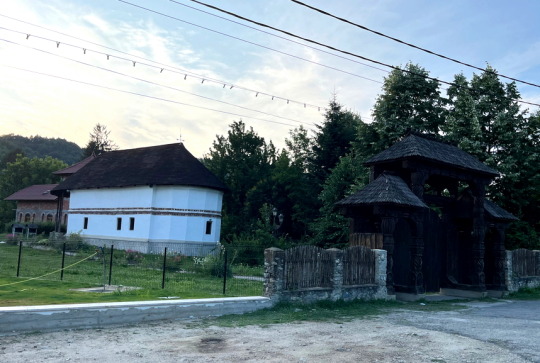
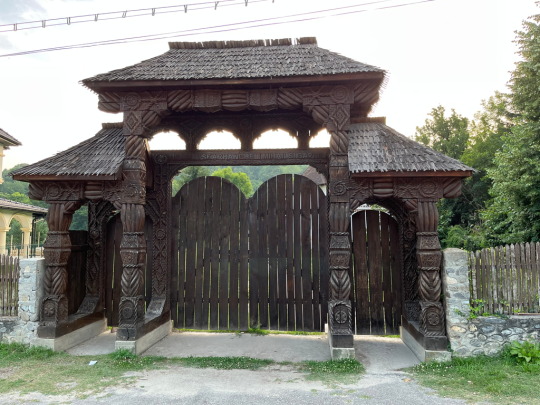
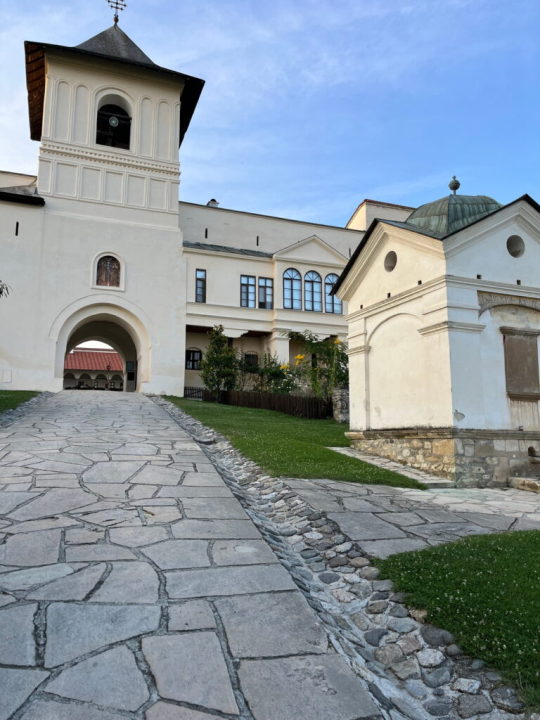
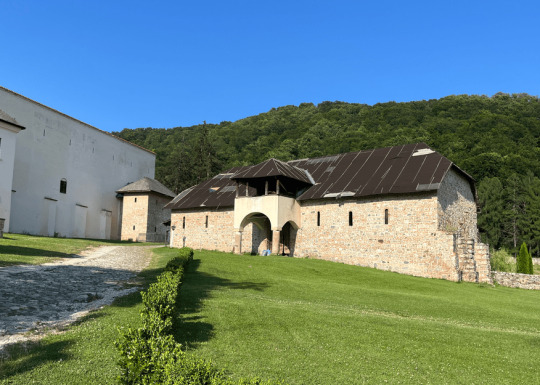
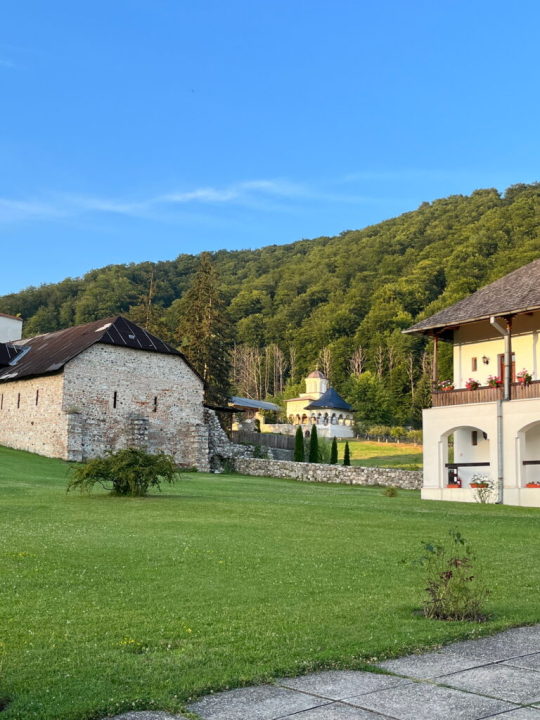
Ich trete durch den äußeren Torbogen und bin zunächst erstaunt, das Kloster in weißer, schlichter Eleganz vor mir zu sehen.

Doch dann durchquere ich das innere Tor und stehe im stimmungsvollen Innenhof voller Blumen, der von der Abendsonne in goldenes Licht getaucht wird.
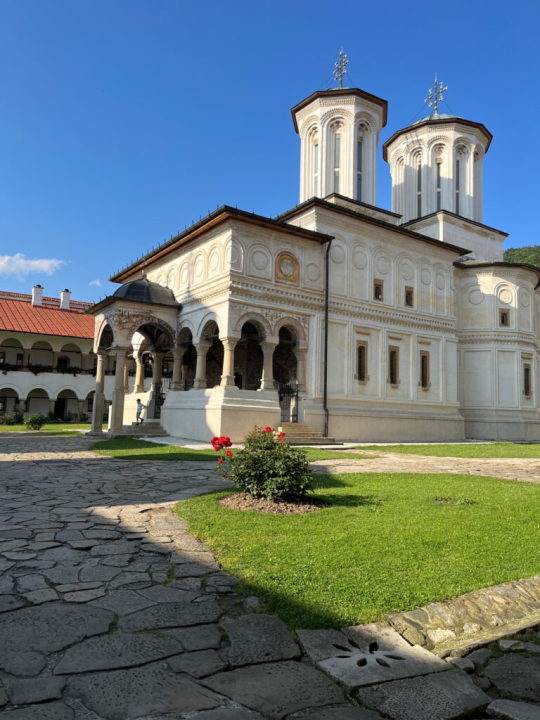
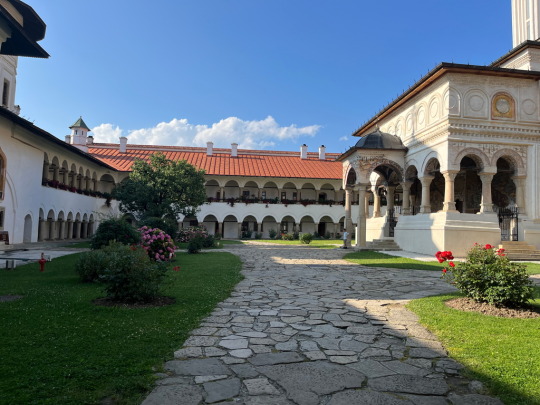
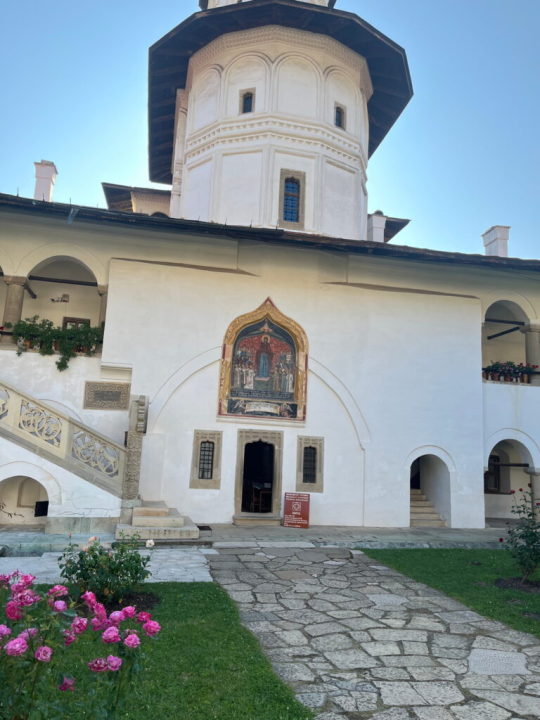

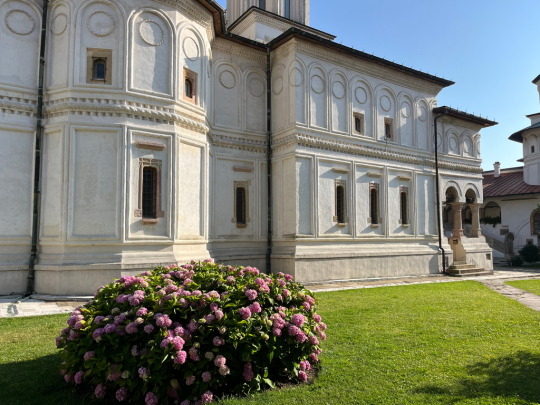

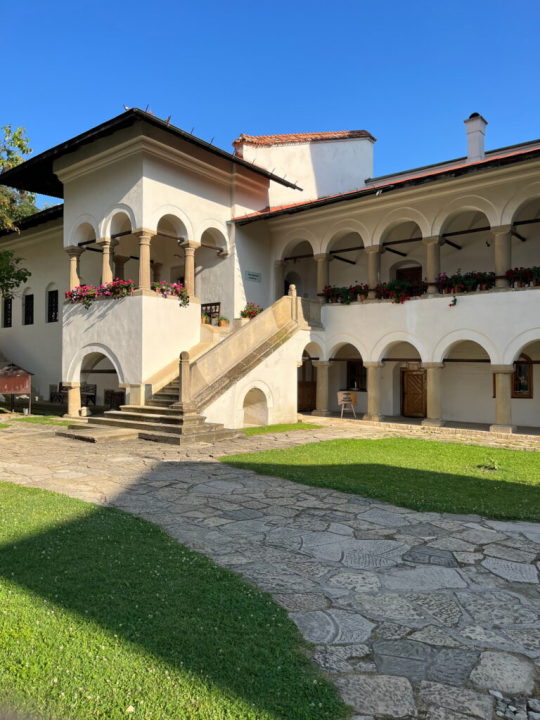

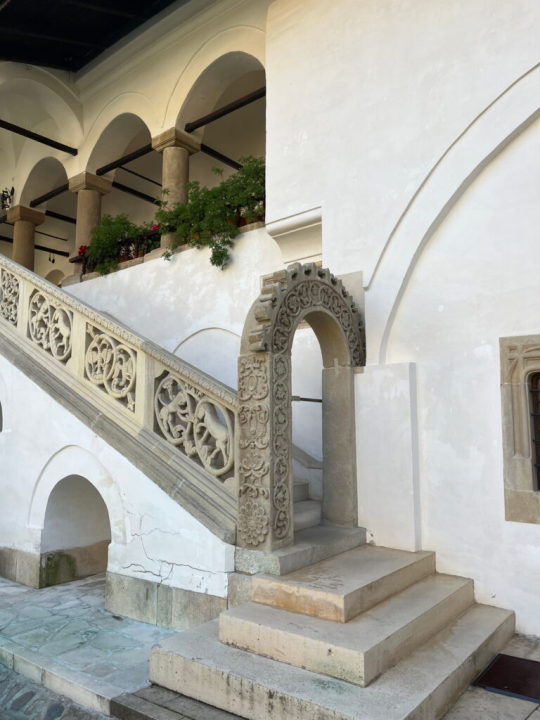
Die üppig bemalte Kirche ist eine der schönsten, die ich je besucht habe. Das Kloster ist bis heute in Betrieb und einige Gläubige sind in die Kirche gekommen, deshalb sind im Inneren keine Fotos erwünscht. Doch schon die Malereien im Außenbereich geben einen kleinen Vorgeschmack.
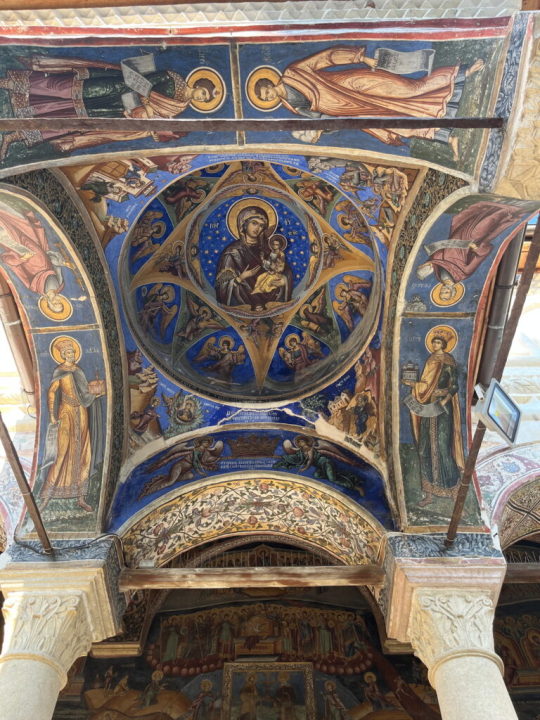
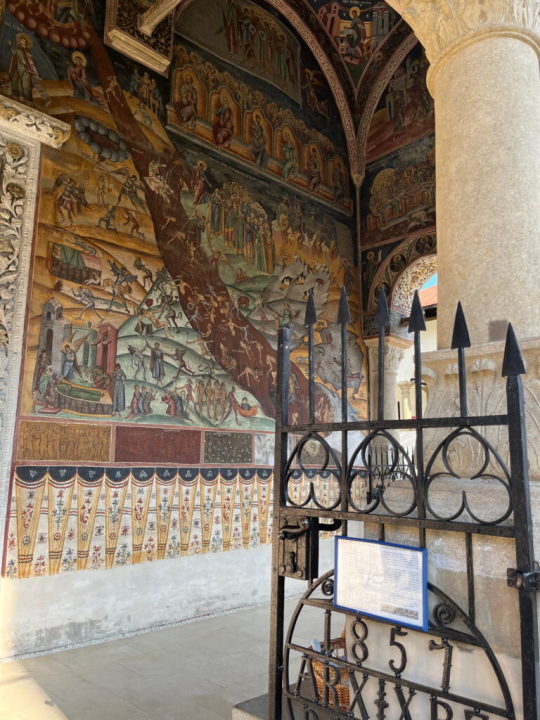
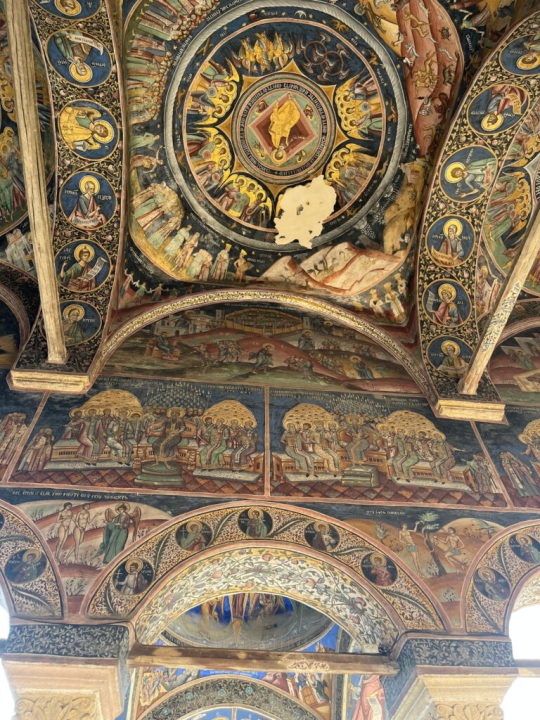



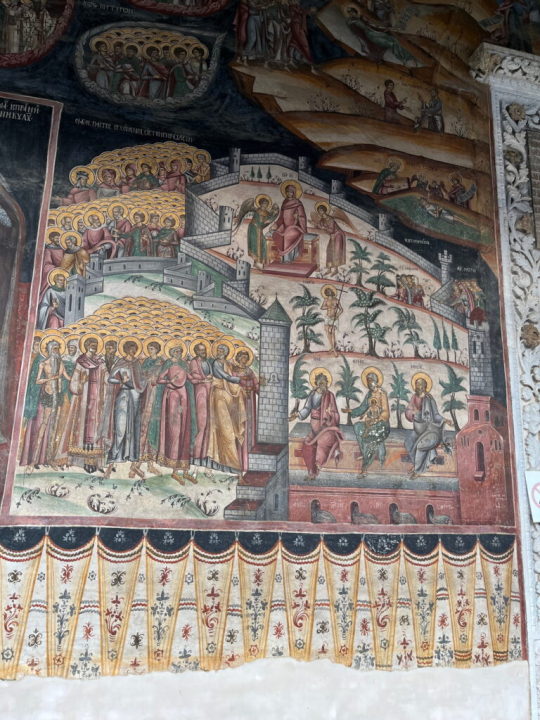

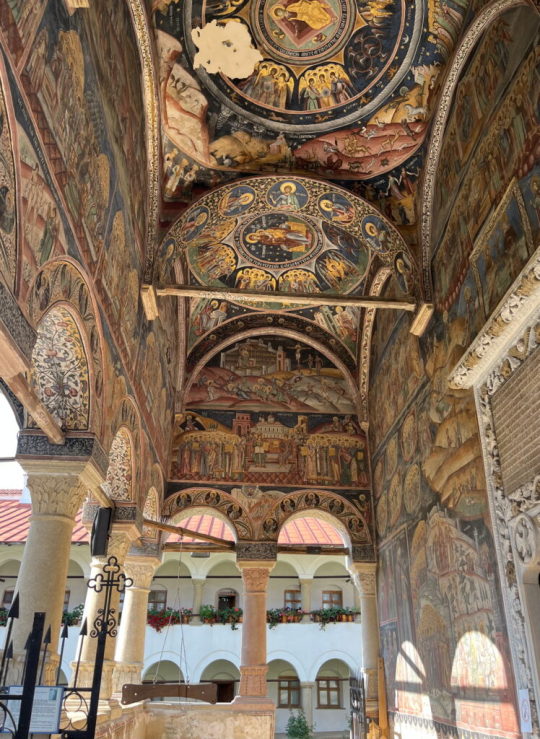
Auch das Refektorium ist für Besucher offen und ich stehe auch hier voller Staunen.

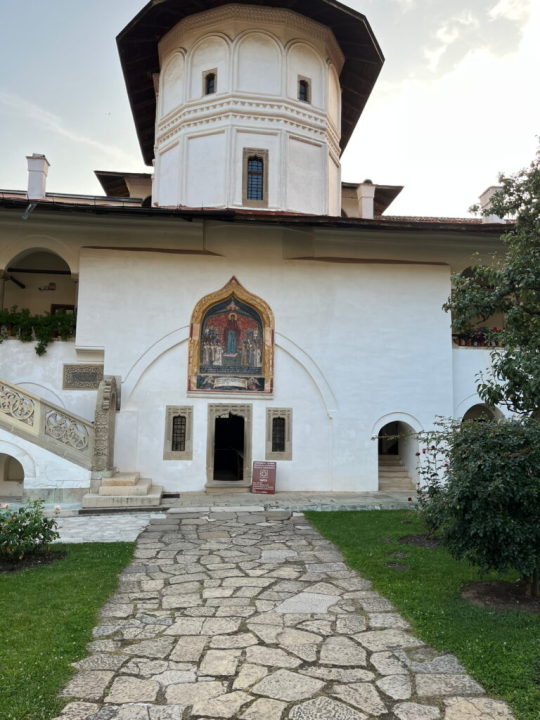

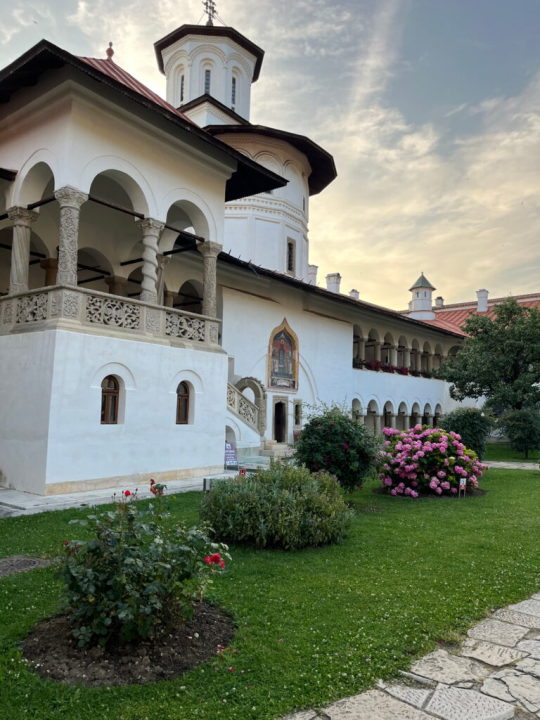
Es ist Abend geworden und die Vögel umkreisen in den letzten Sonnenstrahlen die Kirchtürme.
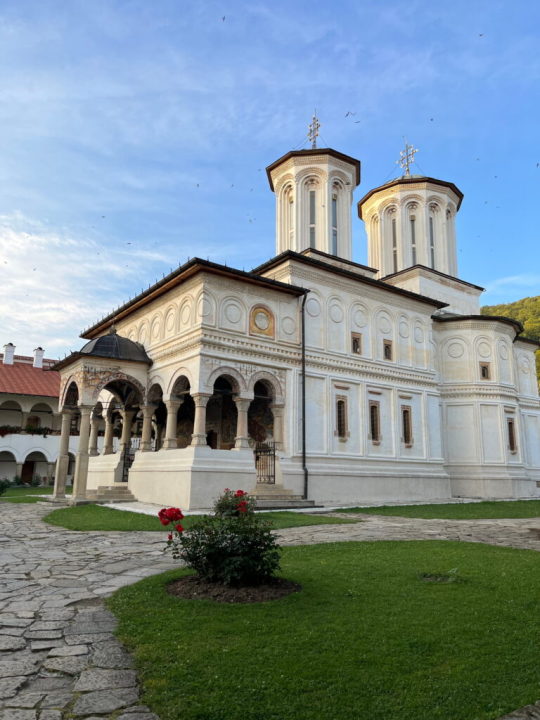
Ich habe unweit des Klosters übernachtet und am Morgen, pünktlich zum Weckruf mit dem Schlagen der Bretter, trete ich durch die schweren Tore, stehe noch einmal im Klosterhof und sehe zu, wie es zum neuen Tag erwacht. Dann nehme ich Abschied von diesem wunderbaren Ort.
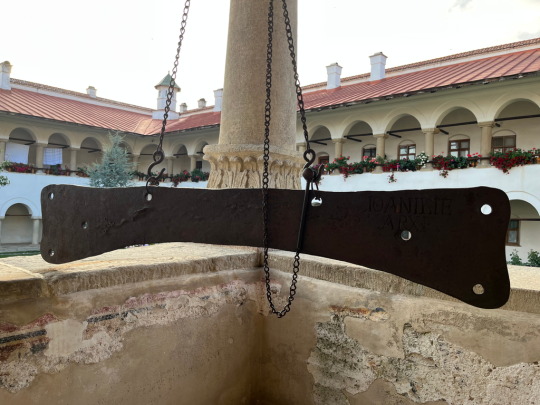
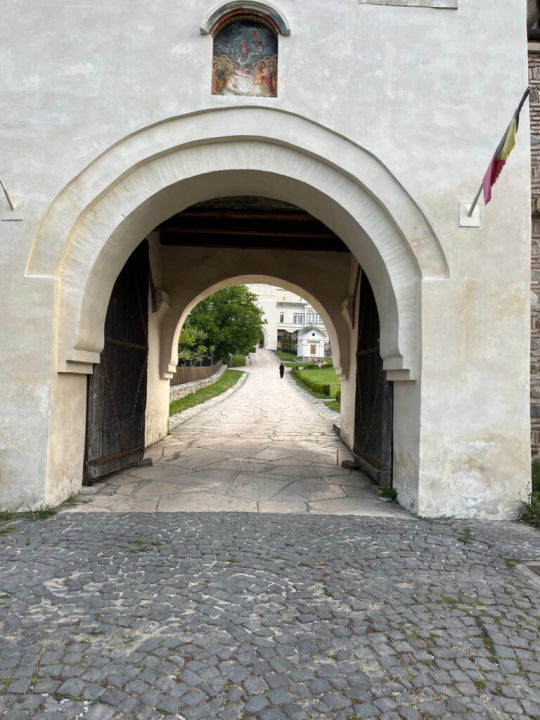


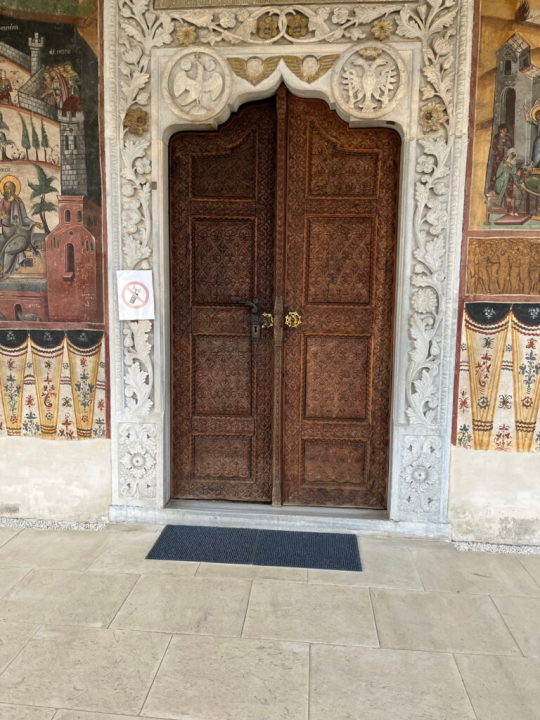
Resümee
Das Kloster Horezu ist einer der Orte, die man in Rumänien unbedingt besuchen sollte. Seine Tore stehen für die Gäste von Sonnenauf- bis Sonnenuntergang offen, und sogar völlig kostenlos. Die wunderbaren farbenfrohen Malereien und die besondere Stimmung im Inneren der Kirche muss man einfach selbst erlebt haben. Das Klostergelände und die weitere Umgebung laden zu Spaziergängen ein und als kleine kulinarische Erinnerung an den Besuch bieten die Nonnen im Klosterladen Marmeladen und Säfte aus eigener Herstellung an.
Die gesamte Tour go-south 2.0 ist hier beschrieben. Hier gehts zu meinem Welterbe-Projekt. Der Umbau meines Dacia Dokker als Minicamper ist hier detailliert nachzulesen. Dobbys nach und nach angepasste Einrichtung und Ausstattung hat sich auch in diesem megaheißen Sommer bewährt. Meine Übernachtungsplätze habe ich wieder auf park4night gesucht und unter 5Reisende bewertet.
Read the full article
#Abenteuermobil#Abenteuerreise#AlbaIulia#alleinunterwegs#Alleinreisen#Ausbau#Ausrüstung#Autoreise#Besichtigung#Camping#Camping-Mobil#Dacia-Dokker#DIY#Dobby#Erfahrungsbericht#Erkundung#Europa#Hochdach-Kombi#Inspiration#KlosterHorezu#Leichtbau#Minicamper#Parkplatz#Reisebericht#Reisefotografie#Reisetagebuch#Reiseziele#Roadtrip#Rumänien#Rundfahrt
0 notes
Text
ISTORICUL CASEI DE PE STR. MITROPOLIEI, NR. 17, ÎN SECOLELE XVII−XVIII
„Das Stampfen Haus” a fost în proprietatea Familiei Stamp(f) timp de peste 100 de ani. Greger Stamp, negustor și cetățean al orașului Sibiu, a murit în 27 februarie 1630, la vârsta de 44 de ani; a fost înmormântat în Biserica Evanghelică din Sibiu.
Testamentul lui Greger Stamp, redactat la sfârșitul lunii iulie 1630, se întinde pe 19 pagini, scrise mărunt; casa de pe Fleischergasse (în valoare de 800 taleri imperiali), împreună cu celelalte proprietăți și bunuri ale sale au fost împărțite între văduva sa, Agnetha, și cei doi fii minori, Michael și Greger jr. Fresca datată în anul 1628 a fost, fără îndoială, comandată de tată pentru cei doi băieți ai săi. Scena − însoțită de inscripția cu minuscule gotice − „Historia de prodico [sic] filio” (Istoria/Parabola Fiului risipitor) − este amplasată „în oglindă”, pe peretele opus, cu scena unei familii așezată la masă, ai cărei membrii cer binecuvântarea divină înainte să înceapă să mănânce, temă inspirată din Vechiul Testament (scena din urmă este foarte degradată, iar inscripția de deasupra, ilizibilă). Portretul dublu al băieților este reprezentat în frescă, într-un medalion – situat în dreapta scenei de familie.
La 24 aprilie 1637, Michael, fiul cel mare al „prea stimatului Greger Stamp” (expresie care subliniază faptul că amintirea tatălui său era încă prezentă în oraș), a fost luat ucenic de meșterul aurar Lucas Löw, pentru a învăța timp de 4 ani arta orfevrăriei, în orașul regal Sibiu („als er in der königliche Stadt, die Kunst des Goldschmiedens zu lehrnen auff 4 Jahr”). Michael Stamp a continuat să locuiască în casa părintească până la moartea sa în 1670; fragmentul de inscripție „I./ M.S./...”, de pe stâlpul din dreapta dublului portret al băieților, pare să reprezinte inițialele numelui său.
Casa a rămas moștenitorilor familiei în deceniile următoare, până în anul 1733, când „das Stampfen Haus” a fost achiziționată de Samuel Dobosi (1694−1759) – comerciant și bancher de succes. Regulamentul de funcționare a fântânii de pe Fleischergasse din anul 1744 (Brunnen Ordnung), construită în același an (Rohr-Brunn Etablisment, 1744) din inițiativa și cu sprijinul financiar al lui Samuel Dobosi, Mercator), ne furnizează informația că fântâna era situată în apropierea casei pe care Samuel Dobosi a cumpărat-o și a reconstruit-o din ruină („ ... und statt dort, von seineren gekaufftem, und aus dem ruin, neuerbautem Hauß”). Frumoasa și eleganta soție a lui Samuel Dobosi, Agnetha Vankhel von Seeberg (1708−1791), a continuat să locuiască în casă până la sfârșitul vieții sale. Din căsătoria lor – în anul 1724 – au rezultat două fete, care s-au măritat cu Johann Schunn (vicenotar în Sibiu) și Carol de Sachsenfels (jude în Tălmaciu și castelan la Turnu Roșu); cei doi gineri ai lui Samuel Dobosi – în calitate de succesori − au deschis un lung proces (1760-1803) de recuperare a datoriilor rămase din partea marelui ban Constantin III Brâncoveanu.
Bibliografie:
Daniela Dâmboiu, „Identificarea comanditarului frescelor din interiorul Casei de pe Str. Mitropoliei, nr. 17, Sibiu”. În: Studia Universitatis Cibiniensis. Series Historica, vol. XVII, 2020, pp. 125-139.
Dana Jenei, „Murals from 1628 painted inside the House of 'Greger Stamp, circvumsp(ecti) viri Domini […] Civis et Mercantoris Civit(atis) / Cib(iniensis) optimi' ”. În: Brvkenthal. Acta Mvsei, XIV.2, 2019, pp. 341-353.
1. „Brunnen in der Fleischergasse”. Desen, anonim, 1745. (Emil Sigerus, Von altem Hermannstadt, I, Hermannstadt, 1922, p. 189.)
2. „Parabola Fiului risipitor”. Detaliu frescă, anonim, 1628
3. Dublul portret al băieților Stamp. Frescă, anonim, 1628
4. Portretul lui Samuel Dobosi, Mercator (1694−1759). Anonim transilvănean, mijlocul sec. al XVIII-lea (Muzeul Național Brukenthal)
5. Portretul Agnethei Vankhel von Seeberg (1708−1791), soția lui Samuel Dobosi. Anonim transilvănean, mijlocul sec. al XVIII-lea (Muzeul Național Brukenthal)



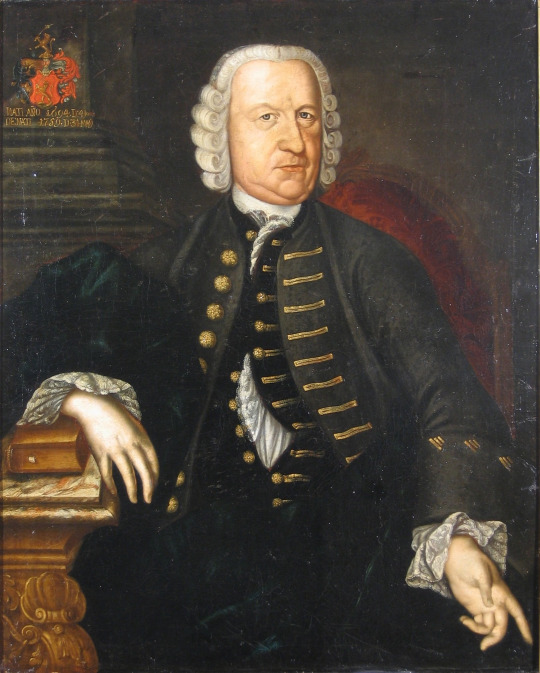

1 note
·
View note
Text
Gabriel Constantin - Curtea Domnească din București în vremea lui Constantin Brâncoveanu
Gabriel Constantin – Curtea Domnească din București în vremea lui Constantin Brâncoveanu
Domnia lui Constantin Brâncoveanu a însemnat perioada de maximă înflorire a Curții Domnești din București, fapt care, într-un cadru mai larg, s-a înscris în registrul bogăției edilitare a Capitalei lăsată moștenire de către Brâncoveanu.
Amprenta înnoitoare a operei brâncovenești s-a reliefat foarte sugestiv…

View On WordPress
0 notes
Text
Retrospectivă istorică privind începuturile activităţii de informaţii pe teritoriul românesc
Din punct de vedere politic, Ţările Române îşi stabilizează situaţia internă. În plan extern, reuşesc să-şi îmbunătăţească relaţiile cu alte state şi în primul rând, cu cele vecine. În plan intern, domnitorii întreprind măsuri organizatorice inspirate şi utile. De reţinut în acest sens, preocupările constante ale lui Şerban Constantin, Constantin Cantemir şu Constantin Brâncoveanu în privinţa…

View On WordPress
0 notes
Photo

☕Cafetaria B I A Coffee To Go este un loc de relaxare unde clienții se pot bucura de gamă diversificată de cafele, ceaiuri sau băuturi răcoritoare. Aceasta este situată într-un loc public, vis a vis de Liceul Teoretic "Brâncoveanu Vodă" din Urlați. Cafetaria este amenajată într-un stil confortabil și relaxant, cu mobilier adecvat. Ce poți să găsești ? Ristrette, Americano, Espresso, Espresso lung, Macchiato, Picollo Latte, Cappucino, Caffe Latte, Frappe etc. Cu stimă, Echipa @urlati.ro #URLATI #OrasulDintreVii #DrumulVinului #BIACoffeToGo (at URLATI.ro) https://www.instagram.com/p/CqH09bZq4sO/?igshid=NGJjMDIxMWI=
0 notes
Text
PR. CONSTANTIN SÂRBU ȘI BISERICA SAPIENȚIEI, de Monah Teodor Stănescu
PR. CONSTANTIN SÂRBU ȘI BISERICA SAPIENȚIEI, de Monah Teodor Stănescu
Biserica Sapienţiei
Biserica Sapienţei este situată pe strada cu acelaşi nume, foarte aproape de podul Izvor. Ea este ctitoria Saftei Brâncoveanu şi a familiilor Creţulescu, Lahovari, şi Slătineanu, care aveau viile pe dealul din apropiere în vechime. Aceste familii înstărite au construit bisericuţa Sapienţei pentru sufletele lor cuvioase, ca metoc. Biserica avea o turlă care datorită…

View On WordPress
#biserica Sapientiei#despre Sfintii Martiri din temnitele comuniste#Monah Teodor Stănescu#pr. Constantin Sârbu#preotul sfânt din Bucuresti
0 notes
